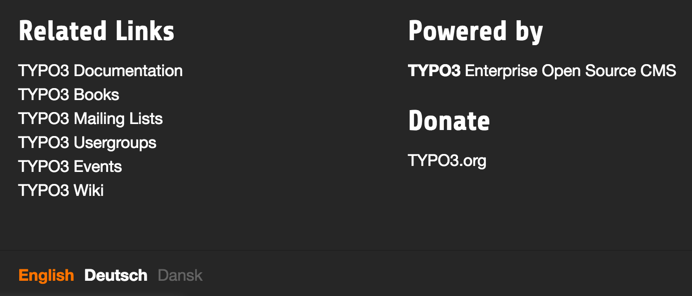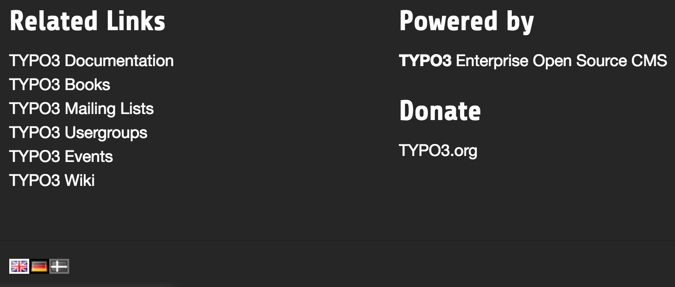Attention
TYPO3 v9 has reached its end-of-life September 30th, 2021 and is not maintained by the community anymore. Looking for a stable version? Use the version switch on the top left.
You can order Extended Long Term Support (ELTS) here: TYPO3 ELTS.
Language selection menu¶
To properly navigate a multilingual web site you probably want to have a language selection menu somewhere. This menu should show an entry for each possible, with variation of aspect depending on translation availability, i.e.:
Translation exists
Translation exists - currently selected
Missing translation
Missing translation - currently selected
This kind of menu can be made by TypoScript and the HMENU content object with special type language.
Such a menu answers to the above requirements by using four different item states, respectively "NO", "ACT", "USERDEF1" and "USERDEF2".
TMENU example¶
The Introduction Package comes with a text-based rendering of the language menu, located in the footer.

A text-based language menu, with active and disabled states¶
This is the corresponding code:
lib.language = COA
lib.language {
20 = HMENU
20 {
special = language
special.value = 0,1,2
special.normalWhenNoLanguage = 0
wrap =
1 = TMENU
1 {
noBlur = 1
NO = 1
NO {
doNotLinkIt = 1
linkWrap = <li>|</li>
stdWrap.override = English || Deutsch || Dansk
stdWrap {
typolink {
parameter.data = page:uid
additionalParams = &L=0 || &L=1 || &L=2
ATagParams = hreflang="en-GB" || hreflang="de-DE" || hreflang="da-DK"
addQueryString = 1
addQueryString.exclude = L,id,no_cache
addQueryString.method = GET
no_cache = 0
}
}
}
ACT < .NO
ACT.linkWrap = <li class="active">|</li>
USERDEF1 < .NO
USERDEF1 {
linkWrap = <li class="text-muted">|</li>
stdWrap.typolink >
}
USERDEF2 < .ACT
USERDEF2 {
linkWrap = <li class="text-muted">|</li>
stdWrap.typolink >
}
}
}
wrap = <ul id="language_menu" class="language-menu">|</ul>
}
Hint
Having "Page not found (404) trouble?"
The reason may be a 'cHash' problem.
See if you can find help in this discussion. Check whether
you have 'cHash' in line addQueryString.exclude = L,id,no_cache
above.
GMENU example¶
It is also possible to go for a graphical rendering, with the GMENU object, for example to create a menu based on flag icons. For this, we need to replace the existing code with something like:
lib.language.20 >
lib.language.20 = HMENU
lib.language.20 {
special = language
special.value = 0,1,2
special.normalWhenNoLanguage = 0
1 = GMENU
1.NO {
XY = [5.w]+4, [5.h]+4
backColor = black
5 = IMAGE
5.file = fileadmin/flags/gb.png || fileadmin/flags/de.png || fileadmin/flags/dk.png
5.offset = 2,2
}
1.ACT < .1.NO
1.ACT = 1
1.ACT.backColor = white
1.USERDEF1 < .1.NO
1.USERDEF1 = 1
1.USERDEF1.backColor = gray
1.USERDEF1.10 = EFFECT
1.USERDEF1.10.value = gray
1.USERDEF1.noLink = 0
1.USERDEF2 < .1.USERDEF1
1.USERDEF2.backColor = green
}
which will result in:

A graphical language menu, with active and disabled states¶
